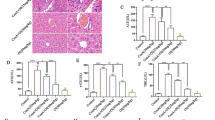Abstract
Previous study on TNFR1-mediated hepatocyte apoptosis has been implicated in the development of fulminant viral hepatitis. To interfere with the potentially effective target, plasmid named p-mTNFR1shRNA complimentary to the sequence responsible for mTNFR1 was also constructed and further confirmed by sequence analysis. To investigate the effect of mTNFR1shRNA plasmid on mTNFR1 expression in vivo and the disease progress in MHV-3 induced fulminant hepatitis mice model. By hydrodynamic injection of mTNFR1shRNA plasmid, the survival rate of mice, hepatic pathological change were examined and compared between mice with/without mTNFR1shRNA plasmid intervention. The expression of mTNFR1 was detected by Real-time PCR, immunohistochemistry staining. The mTNFR1shRNA plasmid significantly reduced mTNFR1 expression in vivo, markedly ameliorates inflammatory infiltration, prolonged the survival time period and elevated the survival rate from 0 up to 13.3% in Balb/cJ mice with MHV-3 induced fulminant hepatitis. This study was designed to explore the opportunity of RNA interference technique in inhibiting TNFR1 expression, which has been reported to be involved in the development of a variety of diseases including fulminant viral hepatitis and severe chronic hepatitis B.
Similar content being viewed by others
Reference
Barbosa A S, Lin C J. 2004. Gene silencing with RNA interference: a novel tool for the study of physiology and pathophysiology of adrenal cortex. Arq Bras Endocrinol Metabol, 48(5): 612–619.
Bang S, Jeong E J, Kim I K, et al. 2000. Fas and tumor necrosis factor-mediated apoptosis uses the same binding surface of FADD to trigger signal transduction. A typical model for convergent signal transduction. J. Biol. Chem. 275: 36217–36222.
Chan F K, Lenardo M J. 2004. A crucial role for p80 TNFR2 in amplifying p60 TNFR1 apoptosis signals in T raves DT. Apoptotic effects of LPS on fibroblasts are indirectly mediated through TNFR1. J Dent Res, 83(9): 671–676.
Cheng V C, Lo C M, Lau G K, et al. 2003. Current issues and treatment of fulminant hepatic failure including transplantation in Hong Kong and the Far East. Semin. Liver Dis, 23, 239–250.
Costelli P, Aoki P, Zingaro B, et al. 2003. Mice lacking TNFalpha receptors 1 and 2 are resistant to death and fulminant liver injury induced by agonistic anti-Fas antibody. Cell Death Differ, 10(9): 997–1004.
Elbashir S M, Harborth J, Lendeckel W, et al. 2001. Duplexes of 21-nucleotide RNAs mediate RNA interference in cultured mammalian cells. Nature, 411 494–498.
Jacque J M, Triques K, Stevenson M. 2002. Modulation of HIV-1 replication by RNA interference. Nature, 418(6896): 435–438.
Kapadia S B, Brideau-Andersen A, Chisari F V. 2003. Interference of hepatitis C virus RNA replication by short interfering RNAs. Proc Natl Acad Sci USA, 100: 2014–2018.
Ledgerwood E C, Pober J S, Bradley J R. 1999. Recent advances in the molecular basis of TNF signal trans- duction. Lab. Invest. 79: 1041–1050.
Nagaki M, Iwai H, Naiki T, et al. 2000. High levels of serum interleukin and tumor necrosis factor alpha are associated with fatality in fulminant hepatitis. J Infect Dis, 182(4): 1103–1108.
Pfeffer K T, Matsuyama T M, Kundig A, et al. 1993. Mice deficient for the 55-kD tumor necrosis factor receptor are resistant to endotoxic shock, yet succumb to L. monocytogenes infection. Cell, 73: 457.
Reynolds A, Leake D, Boese Q, et al. 2004. Rational siRNA design for RNA interference. Nat Biotechnol, 22(3): 326–330.
Schomber T, Kalberer C P, Wodnar-Filipowicz A, et al. 2004. Gene silencing by lentivirus-mediated delivery of siRNA in human CD34+ cells. Blood, 103: 4511–4513.
Song E, Lee S K, Wang J, et al. 2003. RNA interference targeting Fas protects mice from fulminant hepatitis. Nat Med, 9(3): 347–351.
Varfolomeev E E, Boldin M P, Goncharov T M, et al. 1996. A potential mechanism of ‘cross-talk’ between the p55 tumor necrosis factor receptor and Fas/APO1: proteins binding to the death domains of the two receptors also bind to each other. J. Exp. Med. 183: 1271–1275.
Zhu C L, Sun Y, Yan W M, et al. 2006. Novel mfgl2 antisense plasmid inhibits mfgl2 expression and ameliorates MHV-3 induced fulminant hepatitis in Balb/cJ mice. Human Gene Therapy, 17: 589–600.
Zaehres H, Lensch M W, Daheron L, et al. 2005. High-efficiency RNA interference in human embryonic stem cells. Stem Cells, 23(3): 299–305.
Author information
Authors and Affiliations
Corresponding author
Additional information
Foundation items: National Science Fund of China (NSFC) (30571643, 30672380, 30700702); National Key Basic Research Program of China (2005CB522901, 2007CB 512900).
Rights and permissions
About this article
Cite this article
Gao, S., Wang, M., Guo, Jw. et al. Construction of mTNFR1shRNA plasmid and its biological effects on MHV-3 induced fulminant hepatitis in BALB/cJ mice. Virol. Sin. 25, 52–58 (2010). https://doi.org/10.1007/s12250-010-3072-x
Received:
Accepted:
Published:
Issue Date:
DOI: https://doi.org/10.1007/s12250-010-3072-x




